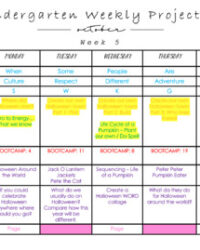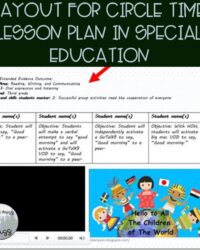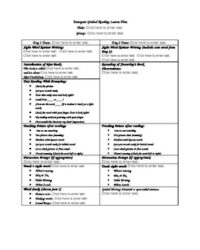Ever felt like you’re trying to catch mist in a net when planning for young learners? Traditional lesson plans can feel rigid and often don’t quite capture the dynamic, evolving interests of children. That’s where the magic of emergent curriculum comes in, focusing on what children are curious about right now, rather than a predetermined schedule. It’s all about observing, listening, and responding to their natural inquiries, letting their fascinations lead the way in discovery and learning.
While the concept sounds wonderfully free-flowing, educators sometimes wonder how to keep track of these organic learning journeys without a solid framework. This is where an emergent curriculum lesson plan template becomes an invaluable tool. Far from being a rigid dictate, it acts as a flexible guide, helping you document observations, brainstorm possibilities, and ensure that the spontaneous moments of learning are not only recognized but intentionally nurtured. It’s about bringing structure to spontaneity, allowing you to reflect on past explorations and anticipate future ones, all while staying true to the child-led philosophy.
Understanding the Flexible Framework of an Emergent Curriculum
Emergent curriculum thrives on responsiveness. It’s an approach that respects children as capable co-constructors of their own learning, with educators acting as facilitators, observers, and documenters. Imagine a child captivated by a tiny ant on the playground – instead of moving on to a pre-planned activity, an emergent curriculum allows you to pause, explore the world of insects, bring in magnifying glasses, books, and perhaps even start a class ant farm. This journey wasn’t pre-scripted; it emerged from the child’s spontaneous interest.
The challenge, however, isn’t in embracing this flexibility, but in ensuring that these rich, fleeting moments of exploration lead to deep, meaningful learning. How do you remember all the incredible questions children asked, the theories they proposed, or the new skills they developed? This is precisely why an emergent curriculum lesson plan template isn’t a contradiction, but a supportive framework. It’s designed not to dictate what happens, but to help you capture, connect, and expand upon the learning that is already happening organically.
Think of the template as your personal reflective journal and brainstorming space. It provides dedicated areas for you to note observations of individual children or groups, jot down their questions and interests, and then ideate potential follow-up activities, resources, and connections to broader learning goals. It’s a way to organize the beautiful chaos of child-led learning, ensuring that you don’t miss opportunities to deepen understanding or introduce related concepts.
Using such a template regularly helps educators become more attuned to their students’ cues. It encourages a continuous cycle of observation, reflection, planning, and implementation. It transforms scattered insights into cohesive learning threads, making the emergent curriculum not just a philosophy, but a practical, well-documented approach to education. Ultimately, it strengthens the partnership between child and educator, fostering an environment where curiosity is celebrated and learning is a shared adventure.
Observing and Documenting Child Interests
The cornerstone of any emergent curriculum is keen observation. Before you can even think about what goes into an emergent curriculum lesson plan template, you need to become a master observer. This means truly seeing and hearing children – noticing what captures their attention, what questions they ask, what problems they try to solve, and how they interact with materials and peers. It’s about being present and allowing yourself to be led by their natural curiosity, rather than directing it.
Once an interest sparks, the next crucial step is documentation. This isn’t just about jotting down a quick note; it’s about capturing the richness of the moment. You might record direct quotes from children, descriptions of their actions, photographs of their creations, or even short video clips. These pieces of documentation become the raw material for your emergent curriculum lesson plan template, providing concrete evidence of interests that can be revisited and expanded upon.
From Interest to Exploration
After observing and documenting, the template guides you in transforming those initial sparks into deeper explorations. This involves brainstorming how to extend the learning. If a child is fascinated by shadows, for example, your template might prompt you to consider:
- What materials could we introduce to explore shadows further (flashlights, translucent objects, overhead projectors)?
- What questions could we ask to encourage deeper thinking (Where do shadows come from? Why do they change size? Can we make a shadow dance?)?
- How can we connect this interest to other areas of learning (art, science, literacy)?
- What prior knowledge do children bring to this topic?
- What are the potential next steps or open-ended invitations for learning?
This systematic approach ensures that spontaneous interests don’t fizzle out but evolve into rich, multi-faceted learning experiences, making every moment a potential educational opportunity.
Crafting Your Ideal Emergent Curriculum Lesson Plan Template
There’s no one-size-fits-all when it comes to designing your perfect emergent curriculum lesson plan template, and that’s precisely the beauty of it. The best template is one that truly works for you, your unique teaching style, and the specific needs of the children you’re working with. It should feel like a supportive companion, not another piece of administrative burden. Customization is key; think about what information is most valuable for you to track and reflect upon.
When you sit down to create or adapt a template, consider its primary purpose: to help you keep track of the dynamic flow of emergent learning. It should be easy to use quickly in the moment, as well as a robust tool for reflection later on. A truly effective template will allow you to see connections, identify patterns in children’s interests over time, and ensure that all children have opportunities for their curiosities to be explored.
Remember, this template is a living document, just like the curriculum it supports. Don’t be afraid to tweak and refine it as you go. What works perfectly for one project or group of children might need adjustments for another. The goal is to develop a tool that empowers you to respond authentically to children’s learning, making your practice more intentional and joyful. It’s all about finding that sweet spot between flexibility and effective organization.
Here are some essential elements to consider including in your own emergent curriculum lesson plan template:
- **Date and Context:** When did this observation occur? What was the general setting or activity?
- **Observation Notes:** Detailed notes on what children said, did, and expressed interest in. Include specific quotes or actions.
- **Child(ren) Involved:** Who was involved in this particular moment of interest?
- **Educator Reflection:** What did you notice? What questions did this observation raise for you?
- **Emergent Ideas/Provocations:** Brainstormed ideas for how to extend the learning, potential materials to introduce, or questions to pose.
- **Learning Connections:** How does this interest connect to broader developmental goals or curriculum areas (e.g., literacy, STEM, social-emotional)?
- **Resources Needed:** List of books, materials, or expert connections that might support the exploration.
- **Follow-Up Actions:** Specific steps you plan to take based on the observation and ideas.
- **Outcome/Next Steps:** What happened as a result of the follow-up? Where might the learning go next?
Embracing the concept of an emergent curriculum, supported by a thoughtfully designed template, transforms teaching from a task of delivering information into a dynamic dance of discovery. It’s about building a learning environment where children feel truly seen and heard, and their innate curiosity is the most powerful engine for growth. This approach not only deepens children’s engagement but also enriches the experience for educators, fostering a profound connection to the learning process.
Ultimately, a structured yet flexible approach to emergent curriculum empowers both educators and children to embark on meaningful, personalized educational adventures. It creates a vibrant, responsive classroom where learning isn’t just an activity, but a continuous journey of exploration, wonder, and shared growth, ensuring every day is filled with possibilities sparked by genuine curiosity.


